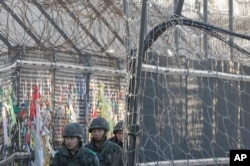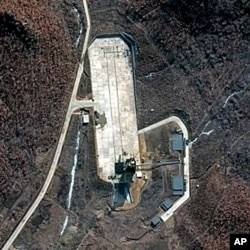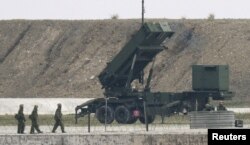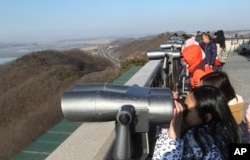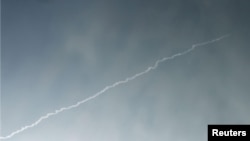North Korea's launch of a long-range rocket Sunday, carrying what it said is a satellite in defiance of U.N. sanctions barring it from using ballistic-missile technology, has led to calls for quick action against Pyongyang.
South Korean President Park Geun-hye called on the U.N. Security Council to quickly act.
“With an understanding that North Korea's nuclear and missile threat is an actual threat against the international community and in opposition to world peace, the U.N. Security Council must make a strong measure immediately,” Park said.
Rocket launch
The rocket was launched Sunday morning from North Korea’s Tongchang-ri satellite launching facility near the northwestern border with China. The rocket headed on a southward trajectory passing over Japan's southern Okinawa islands.
North Korea later released a statement through its official state news agency KCNA confirming the launch.
“Scientists and technicians of the DPRK have completely succeeded in entering an Earth observation satellite called Gwangmyongsong-4 into an orbit, which has been developed according to the nation’s five-year space development plan of 2016,” said a KCNA announcer.
The launch prompted South Korea and the United States to announce Sunday they would explore the feasibility of deploying an advanced missile defense system in South Korea, which China and Russia both oppose, "at the earliest possible date."
US, South Korea reports
The U.S. Strategic Command detected what it called a missile entering space, also indicating the launch was successful. South Korea's Yonhap news agency had earlier reported the rocket failed to reach orbit and instead fell into the sea near South Korea’s Jeju islands.
Japan reportedly did not take action to shoot down the North Korean rocket, despite warnings that it would and putting its ballistic missile defense units on alert.
U.S. defense authorities tracking the rocket’s trajectory say it did not pose a threat to the United States or its allies.
In 2012, North Korea also successfully launched a three-stage rocket putting a satellite into orbit.
Launch denounced
Pyongyang says the rocket launch is part of its peaceful space program to deliver Earth observation satellites into orbit. The North’s space program, however, has been widely denounced as a hostile pretense to advance its nuclear and ballistic missiles technologies, which are banned by U.N. resolutions.
South Korea and the U.S. have decided to begin discussions about deploying a U.S. missile system to South Korea. The comment was made Sunday by Ryu Je-seung, a South Korean Defense Ministry official, in a joint news conference with Thomas Vandal, commander of the Eighth U.S. Army based in South Korea.
Vandal said, "It is time to move forward on this issue. We look forward to close consultation and coordination on that as well as dealing with the threat to peace and stability posed by DPRK."
The U.N. Security Council will meet Sunday to discuss the North Korean rocket launch at the request of the United States, Japan and South Korea.
U.N. Secretary-General Ban Ki-moon said it was "deeply deplorable that (North Korea) has conducted a launch using ballistic missile technology in violation of relevant Security Council resolutions.”
U.S. Secretary of State John Kerry issued a statement condemning Pyongyang for “a flagrant violation of U.N. Security Council Resolutions” related to the use of “ballistic-missile technology.”
Japanese Prime Minister Shinzo Abe also denounced the North Korean launch and promised to “take action to totally protect the safety and well-being of our people.''
China's official Xinhua news agency Sunday expressed concern that the North Korean rocket launch will worsen tensions on the Korean peninsula and urged "all relevant parties" to exercise restraint.
Increased sanctions
The long-range rocket launch follows North Korea’s fourth nuclear test conducted on January 6.
In response to the nuclear test, the United States and its allies are already advocating for stronger international sanctions against North Korea to impose real economic pain by restricting shipping, aviation, and trade of resources, including coal and fuel.
The U.S. Congress is also working on unilateral sanctions legislation that would target third parties companies and banks - many in China - that do business with North Korea.
South Korea is reportedly considering closing the Kaesong Industrial Complex in response to the North’s rocket launch. The jointly run Kaesong project, that employs over 50,000 North Koreans, is the last surviving inter-Korean development program. Virtually all other inter-Korean ties and assistance programs were severed in 2010 after South Korea accused the North of sinking a navy warship and killing 46 sailors.
For any sanctions to be effective China’s support, as the North’s chief benefactor and trading partner and as a permanent member of the U.N. Security Council, is considered essential.
But Beijing has been reluctant to support harsh punitive measures on Pyongyang that that could lead to instability and further increase regional tensions. Instead it wants all sides to resume international negotiations.
Beijing responded to Sunday's launch, expressing "regret" the North disregarded the opposition from the international community.
Pyongyang says its’ nuclear weapons program is necessary for national defense and non-negotiable.
In early 2009 Pyongyang withdrew from “six party talks” with Washington, Seoul, Tokyo, Beijing and Moscow to dismantle its nuclear weapons program in exchange for economic assistance and security guarantees
Sunday’s launch occurred in the first hours of an accelerated Feb. 7-14 launch time frame Pyongyang announced Saturday. Earlier it had alerted international meteorological and telecommunications agencies the launch would take place Feb. 8-25.
North Korea is believed to be working on miniaturizing a nuclear warhead to mount on a missile, but many experts say it is some time away from perfecting such technology.
North Korea is believed to have over 1,000 Soviet model missiles that can reach targets in South Korea and Japan, and enough plutonium to make eight to 12 nuclear bombs.
Last year U.S. military authorities said they believe North Korea has the ability to miniaturize a nuclear warhead to fit on a KN-08 long range missile, although North Korea has not yet demonstrated this capability.
Youmi Kim in Seoul contributed to this report.





